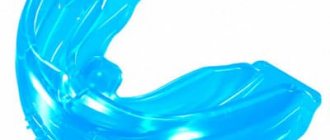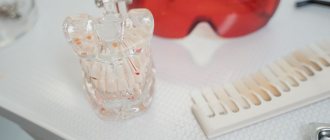Signs of TMJ inflammation
Many people do not pay attention to clicks, crunching sounds, and discomfort when opening and closing their mouth that appear in the TMJ. This happens only until the problem becomes chronic or reaches an acute stage. The following signs are characteristic:
- periodic pain in the jaw joints;
- feeling that some facial muscles are stiff;
- causeless headaches;
- limited joint mobility (inability to fully open or close the mouth);
- discomfort in the neck and back;
- stuffy ears.
Manufacturing stages
After diagnosis and impressions, the doctor creates a model. All subsequent stages of mouthguard manufacturing are carried out in specialized laboratories using two methods.
The first and more accurate is the computer method. When using it, a 3D model is created with the calculation of subsequent aligners (if necessary). This frees the doctor and patient from making intermediate impressions during the treatment process. After calculations, models are made on a 3D printer.
Such models are suitable for spraying (liquid material is sprayed onto the model with the required layer) or vacuum creation of a tray (for the finished plate, the model is shaped using vacuum).
The second method is to make a mouthguard by hand. It is less accurate and requires the creation of intermediate impressions during the treatment process.
For convenience, some specialists make the product partly from wax-like substances that can be melted and remade during the process.
The last step is trimming the finished mouth guard. The first is carried out immediately after production, and the second - during fitting.
What is a release guard?
This is a removable orthodontic structure, which is used in dentistry to relieve tension in the jaw muscles and return the lower jaw to the correct position. A mouthguard is an elastic and transparent overlay for teeth, made individually based on casts of the jaws of a particular patient. It is almost invisible in the mouth.
Such designs are used to correct various malocclusions - moving teeth to the correct position. The disconnecting mouth guard not only moves teeth, but also has a number of other functions:
- normalizes neuromuscular balance, relieving excessive muscle tone;
- stabilizes joints for proper functioning of the lower jaw;
- harmoniously distributes the load on muscles, ligaments, joints;
- changes the trajectory of jaw movement;
- Centers the lower jaw, returning it to its correct position.
Purpose, reasons for violations
Mouthguards are one of the elements of the therapeutic course prescribed for diagnosing pathologies of the functionality of the temporomandibular joint. The department with the greatest mobility in the entire human body ensures the performance of basic tasks such as chewing, speech, respiratory function, etc. Numerous muscles and ligaments are exposed to stress every day, and in the presence of anatomical defects, the resulting tension can persist even during a period of rest, which affects the state of the bite and also provokes negative symptoms.
Incorrect functioning of the masticatory muscles provokes problems such as:
- Deviation in the development of bite;
- Partial or complete restriction of jaw mobility;
- Accelerated erosion of tooth enamel;
- Defragmentation of fillings and crowns;
- Diction problems;
- Headaches and cramps;
- Sleep disorder.
Factors causing TMJ dysfunction have different origins. In some cases, the cause of the pathological condition is constant stress - psychological tension forces the patient to involuntarily clench his teeth, which leads to overload of the muscle structure. A separate pathology of this nature - bruxism - still remains the subject of research aimed at identifying the root cause of its occurrence. In addition, the functionality of the dentofacial apparatus is directly affected by the anatomical arrangement of the elements of the dentition - the displacement of individual units leads to a violation of occlusion.
A mouth guard for muscle relaxation relieves hypertonicity, restores balance, and helps normalize the relationship between the upper and lower jaw. In addition, wearing can be indicated before correcting the bite with braces, installing dentures, as well as during the rehabilitation period after receiving mechanical injuries and damage.
How are release guards made?
In the manufacture of mouth guards, diagnostics plays an important role, since before treatment, a multifaceted functional analysis and accurate calculation are needed. The patient undergoes a computed tomography (CT) examination, as a result of which the doctor receives data on the condition, structure, and anatomical features of the TMJ, muscles, and ligaments. Various studies are used to determine the optimal position of the lower jaw. For example, in some clinics they use physiotherapeutic devices that relax the head muscles and identify disorders that prevent the formation of a normal bite.
The mouthguard is then made in the laboratory using impressions of the patient's jaw. The doctor first calculates the trajectory of movement of the teeth and jaw. It occurs gradually, softly and delicately, unnoticed by the patient himself.
Preparation
At the preliminary stage, it is important to correctly determine the technical characteristics of the future lining. Carrying out a comprehensive diagnosis, the doctor calculates the degree of impact on the jaw muscles, sufficient to normalize the condition of the department. The studies prescribed at the preparatory stage include:
- CT and orthopantomogram;
- Axiography and electromyography;
- Occlusiogram, as well as articulatory analysis.
The quality of closure, vulnerability of the enamel coating, the presence of edentulous areas and parameters of motor amplitude, as well as other criteria important from the point of view of making a mouthguard, are assessed.
Features of treatment
The device is created in a dental laboratory. The basis is jaw casts, as well as indications obtained during diagnostics. The installed mouthguard does not cause pain, relaxes the jaw muscles, and contributes to the formation of correct occlusion. The duration of therapy depends on the severity of the defect and varies from 2-3 months to 1-1.5 years. During treatment, the patient must regularly visit the dental clinic, undergoing a routine examination at least once every two weeks.
Price
The cost of making a mouth guard for muscle relaxation also depends on the complexity of the diagnosed anomaly. Universal overlays that do not take into account anatomical specifics cost 3-4 thousand, but demonstrate insufficient effectiveness. Individual models cost 18-25 thousand rubles, and ensure the achievement of the desired result.
Wearing Features
The disconnecting mouthguard is practically invisible on the teeth; it is worn constantly, removing it only when eating. In some cases, it is enough to wear the structure only while sleeping. The wearing mode is determined by the orthopedic dentist. Since the material is quite thin and elastic, the patient’s diction is preserved. The mouthguard may cause discomfort only in the first days when addiction occurs.
Every 2-3 weeks you need to visit an orthopedist so that he can monitor the progress of treatment and adjust the mouth guard. Usually it is worn for 4-6 months; in complex cases, treatment can take up to a year.
RECOMMENDATION: HOW TO CARE FOR A DISCLOSING MOUTH
Twice a day, during your usual hygiene procedures, you need to rinse the structure with warm, but not hot water, removing plaque with a regular toothbrush. In this case, it is optimal to use toothpaste or antibacterial agents recommended by the dentist. The mouthguards are stored in special containers.
Diagnostic measures
Diagnosis begins with an initial examination, during which the condition of the oral cavity and the severity of malocclusion are assessed. At this stage, it is determined how effective treatment with a mouth guard can be.
Next, a diagnosis is carried out, which includes:
- Orthopantomogram and teleroentgenogram – panoramic photograph of both jaws;
- 3D tomography – joints, jaws and soft tissues are deeply and thoroughly examined;
- Accurate impressions of teeth – necessary for the manufacture of mouth guards as a basis for sculpting;
- Photographs of rows of teeth - for visual inspection during manufacturing;
- Design and functional features are also determined (occlusal patterns, insertion routes and preliminary thickness);
- Sonogram – will detect noises and abnormalities in the joints.
During diagnosis, for the accuracy of all studies, muscle relaxants are used to relax the muscles for measurements.
After diagnosis, the jaw for which a mouthguard will be made is determined. It can be mandibular, maxillary and complete (for two jaws), and the choice depends on the pathology and condition of the oral cavity.
The lower options are preferable, as they are aesthetically attractive and comfortable. The number of mouth guards is also determined, since there are pathologies for which it is necessary to produce up to 50 pieces.
Indications for the use of Invisalign aligners and the unique properties of the product material.
In this publication we will talk about the effectiveness of using mouthguards for bruxism.
Follow the link https://www.vash-dentist.ru/ortodontiya/kapyi/dlya-vyiravnivaniya-zubov-vidyi-dostoinstva-i-osobennosti-ispolzovaniya.html if you are interested in the price of mouth guards for teeth straightening from popular manufacturers.
Reviews
The use of this treatment technique is quite new and many do not risk experimenting, preferring classical methods.
In such a situation, it is very important for doctors and patients to know the opinions of people who have already felt the effect of treatment. Leave your reviews and comments about mouth guards under the article.
If you find an error, please select a piece of text and press Ctrl+Enter.
Tags mouth guards
Did you like the article? stay tuned
Previous article
Detailed instructions for using Swiss paste Pulpotek
Next article
Purpose of Ribbon tape in dentistry and functions assigned to the product
How is treatment performed using unloading mouthguards:
The therapeutic effect of the unloading mouth guard is that, having a certain thickness, it stretches the muscle by a given number of millimeters. Approximately the same thing happens during physical exercises. With constantly repeated exposure, the muscles remember how elastic they should be and with what force they should compress the teeth. In addition, when wearing a mouthguard, your teeth, fillings, restorations and crowns are under its reliable protection. By using a mouthguard, you extend their service life.
Indications for use
Release guards are used for:
- restoration of neuromuscular coordination, relief of muscle hypertonicity, and relaxation;
- increasing the interalveolar distance (bite height);
- reduction and correct distribution of occlusal load, protection from bruxism and parafunctions;
- normalization of the TMJ function, elimination of compression and moderate disturbances in the spatial relationships of intra-articular elements;
- diagnostics of the functioning of the dentofacial apparatus in order to determine TMJ disorders.
Wearing products can also eliminate some aesthetic defects - for example, folds in the chin area and corners of the mouth.
The use of disconnecting splints is contraindicated in case of mental and neurological diseases , or improper development of the upper jaw.
The effectiveness of using disconnect buses depends on the type and severity of anomalies. Successful treatment should not be expected if the severity of TMJ dysfunction is significant.
Tactics of using a chin sling in orthodontics in the treatment of progenia.
This publication is all about the purpose and use of the Kerbitz plate.
Here https://orto-info.ru/sistemyi-vyiravnivaniya-zubov/individualno-izgotovlennyie-apparatyi/elementov.html we will consider the stages of manufacturing elements of removable orthodontic appliances.











